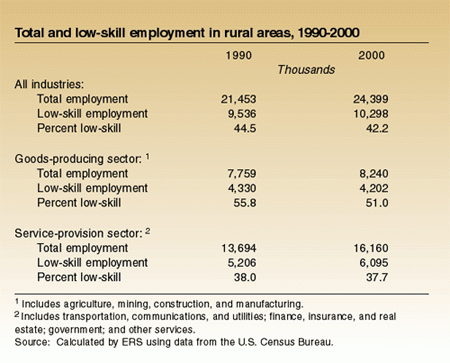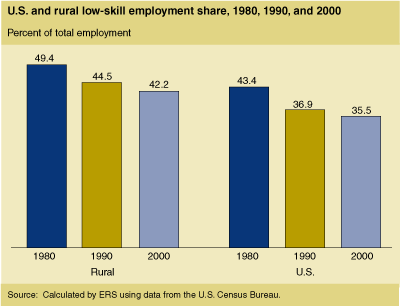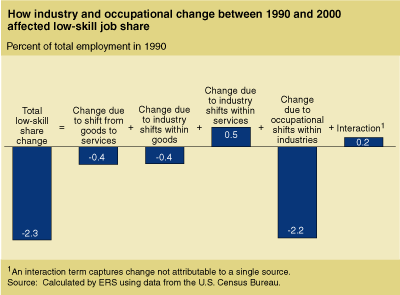Low-Skill Jobs: A Shrinking Share of the Rural Economy
- by Robert Gibbs, Lorin Kusmin and John Cromartie
- 11/1/2004
A signature feature of the 20th-century U.S. economy was the rise in skills required by employers. Jobs involving physical, routine tasks consequently declined as a share of national employment, and their historical predominance in rural areas is waning. In the 1990s, the rural economy slightly outpaced the national decline in low-skill job share, reflecting rural America’s participation in an increasingly skill-intensive national economy. The trend toward a high-skill economy, along with higher wages and less job volatility, is considered a fundamental indicator of economic development.
The long-term decline in rural low-skill jobs stemmed first from a steep decline in farm employment and more recently from declines in rural manufacturing. Today, most low-skill jobs in rural areas are in the service sector—government, trade, and consumer and business services—rather than in the goods production sector represented by agriculture, mining, construction, and manufacturing. Yet the transition to a service economy has been accompanied by rising skill and earnings levels in rural areas, in part because the typical service job is less likely to be low-skill than the typical goods production job. More importantly, shifts to more skilled occupations within industries—not industrial change—drove the drop in the low-skill share of jobs in the 1990s, with distinct implications for rural economic development. Rural areas with limited resources may thus do better to pursue development strategies incorporating skill upgrades within the current mix of industries rather than attempting a significant shift in local industries.
For individual rural workers, jobs requiring higher skills pay substantially more and have better benefits, on average, reducing employees’ need for Federal and State support services. For rural communities, a high-skill job mix indicates an upward development track, making such places less vulnerable to international competition and more attractive to long-term, high-wage employers. Although low-skill jobs (see “Measuring Job Skills”) were still more prevalent in rural areas in 2000 (42 percent) than in the Nation as a whole (35.5 percent), the rate of decline in low-skill share of employment was faster for rural than urban areas in the 1990s. The total number of low-skill jobs in rural areas increased slightly during the 1990s, however, because of robust rural employment growth.
Has the Shift to a Service-Based Economy Slowed the Decline in Low-Skill Jobs?
According to some observers, the shift from a goods-based to a service-based economy has inhibited rural America’s movement along a high-skill economic path. Rural areas are sometimes hard-pressed to compete for the high-skill service sector jobs (for example, financial service jobs) that require high population density, high disposable income, and sophisticated communications and transportation infrastructures. And because average pay is generally lower for jobs in services than in traditional goods, service workers often end up worse off economically than before, widening the gap between top earners and bottom earners.
A more favorable view holds that the goods-to-services shift indicates convergence with higher skilled urban economies. As educational levels and capital investments grow in some rural labor markets, so too does the ability to attract and retain a vibrant high-skill service sector. Furthermore, increasing skill requirements appear to reflect broad changes across the rural economy, not the transition to services per se.
To address this debate, it is helpful to think of the decline in low-skill employment share as an outcome of two types of change: (1) in the kinds of goods and services produced, reflected in industry composition change; and (2) in the way that goods and services are produced, reflected in occupational changes within industries. As an example of the first kind of change, the growth in physicians’ offices and clinics in rural areas in recent decades has helped raise overall rural skill levels because physicians and nurses typically have high-level skills. As an example of the second type of change, the textile industry too has recently helped raise overall rural skill levels as it shifts away from (low-skill) production workers toward (higher skill) managers and other white-collar occupations (although total employment has declined as well). Technological changes may also affect the skill content of particular occupations, by requiring greater computer literacy of clerical workers or fewer computational skills of sales people.
ERS researchers found that, independent of other effects, the goods-to-services transition led to a slight decrease in the low-skill share of rural employment between 1990 and 2000. Employment in the goods-producing sector (relatively low-skill jobs) fell relative to employment in the service sector, resulting in a reduction in the low-skill share. The effect was more pronounced in rural areas because the relative size of the goods-producing sector is larger than in urban areas, and because the low-skill share of rural, goods-producing employment is much higher.
However, the industry mix was also changing within the goods and service sectors themselves during the 1990s. Declines in rural low-skill industries within the goods-producing sector—as in the apparel industry and the yarn, thread, and fabric mill industry—reduced the low-skill employment share. Leading the list of relatively high-skill and rapidly growing goods-producing industries in rural areas were construction and livestock agriculture.
Conversely, shifts between industries in the larger service sector tended to increase the low-skill employment share. Major low-skill service industries with rapid employment growth in rural areas during the 1990s included trucking, department stores, and hotels and motels. High-skill service industries with slow or negative job growth included elementary and secondary schools, colleges and universities, banking, and insurance. Ultimately, the impact of inter-industry shifts within the service sector was smaller than the combined impact of shifts within goods and from goods to services. Hence, the overall impact of industrial change was to reduce the low-skill share of employment in rural areas.
Growth in the rural service sector appears to have contributed to increases in the number of rural high-skill jobs, but were rural workers better off? Service jobs are typically perceived as paying less than jobs in the goods sector, but evidence suggests that the reality is more complicated. Earnings for rural full-time service-sector workers were indeed 17 percent lower than for goods-sector workers in 2000. Among workers in low-skill jobs, wages were 15 percent lower in services than in goods. But many of the low-skill goods jobs that disappeared in rural areas were replaced by higher skill service jobs that paid more. Even among workers with at most a high school diploma, these higher skill service jobs typically paid 11 percent more than low-skill goods jobs.

This finding helps to explain why earnings rose in the 1990s for less educated rural workers as the rural economy shifted toward service provision. So the net effect of employment shifts from goods to services was both to lower the share of rural jobs in low-skill occupations and to raise rural earnings.
Occupational Change—How Much of an Impact?
While industry changes are partly behind the declining low-skill share of employment, a shift in employment toward high- and medium-skill occupations within industries accounted for a larger portion of the decline. Advances in production technology that complement skilled labor or substitute for less skilled labor (such as computer-assisted technology) appear to be the driving force behind the overall drop.
The shift from lower to higher skill occupations within industries was most pronounced in the goods-producing sector. The share of low-skill jobs fell for manufacturing, construction, and agriculture, and the declines were especially large in crop agriculture, lumber mills, and apparel. These industries face intense competition from imports that often vie with low-skill production work.
In services, low-skill job shares fell in professional/business services; communications and utilities; and finance, insurance, and real estate. Hospitals and grocery stores showed especially large shifts toward higher skill occupations in the 1990s. Many of these industries have little or no exposure to import competition, but face significant pressure to reduce costs due to industry restructuring. In many cases, employers in these industries have reconfigured the way that services are provided, often with computer-assisted technologies.
Still, many industries—such as wholesale trade, mining, retail trade, and health services—saw the share of low-skill jobs grow during the 1990s. In rural areas, the low-skill share grew in about a third of all industries (accounting for 32 percent of rural employment). These industries saw substantial increases in their low-skill employment share. Nonetheless, these increases were dwarfed by the increase in occupational skills in the rest of the rural economy, leading to an overall decline in rural low-skill employment share.
Who Was Most Affected by Low-Skill Shifts?
The decline in the low-skill share of jobs from 1990 to 2000 was largest among rural women (-4.3 percentage points) and rural Blacks (-5.2 percentage points). When race and sex are considered simultaneously, the largest declines occurred among Black women (-7.3 percentage points) and White women (-4.9 percentage points). Declines for most other groups were near the rural average of 2.3 percentage points. Hispanics, however, increased their low-skill job share, with an increase of 3.3 percentage points for Hispanic men.
A few key employment shifts accounted for much of the change among groups of workers. First, the share of rural women in managerial and professional occupations grew by nearly half during the 1990s, from 21 to 30 percent of all women employed. And this share grew for women of all racial/ethnic groups. On the other hand, occupations where the share of employment fell differed by race. For White and Hispanic women, the shift was most noticeable out of the sales, clerical, and administrative support group. Blue-collar jobs, nearly all low-skill, led the decline among rural Black women, falling from 30 to 18 percent of Black women’s employment, but held steady among Hispanic women at 17 percent of their overall employment. These jobs tend to be primarily in manufacturing. Black women alone saw large gains in the service occupations. Because the service jobs held by rural Black women are less likely to be low-skill than blue-collar jobs, their movement from blue-collar to service jobs reduced their low-skill employment share.
The increase in low-skill employment among rural Hispanic men results largely from a shift between two occupational groups with high shares of low-skill employment. During the 1990s, low-skill workers became less likely to be employed in farming jobs and more likely to be found in blue-collar manufacturing jobs.
Earnings rose in rural areas for all demographic groups in the 1990s, but the greatest increases occurred among those groups with the largest declines in low-skill share. The association between earnings and higher skills cannot be attributed solely to rising educational levels. For example, even among workers who did not attend college, a lower share employed in low-skill jobs translated into higher earnings overall.
Why Has the Decline Slowed in the Low-Skill Share of Jobs?
What happened to the widely touted rise in job skills of the 1990s? After all, the low-skill share of employment declined by over five percentage points in rural areas, and nearly six points nationally, during the 1980s. Why was the decline in the 1990s so much smaller than in the previous decade? One possibility is that increased immigration may have made less skilled labor cheaper, thereby delaying the shift to higher skill production methods. Where immigration was higher, as in many large metro areas, the decline in low-skill share was generally smaller.
In some cases, technological change may actually have dampened employers’ replacement of less-skilled labor. The mix of technology changes may have shifted from more skill-intensive in the 1980s—such as the introduction of spreadsheet programs for personal computers—to less skill-intensive in the 1990s—such as cash register icons for frequently ordered items in foodservice outlets. This possibility coincides with the wage gap between the most and least educated workers growing more slowly in the 1990s, despite continuing advances in computer technology.
A final possibility is that changing skill requirements within occupations accelerated during the 1990s, which would not have been fully captured by occupation and industry mix changes. A growing body of evidence suggests that the widespread diffusion of computer-related production technologies has changed the content of occupations, from the field to the factory floor to the office cubicle. Further research may allow better explanations for the apparent slowdown in raising skill levels during the 1990s.

Transition to Service Jobs Elevated Rural Job Skills and Earnings
Economic forces have changed the nature of work in rural America, affecting the well-being of workers, their families, and their communities. In the 1990s, these forces led to a gradual upgrading of rural skills, as more and more jobs required higher levels of education and training. Technological change, global shifts in the geography of production, and large investments in human capital prompted rapid growth in jobs requiring high levels of formal education and technical knowledge. Census data confirm that the average educational attainment of rural adults rose along with job skill requirements. Thus, rural areas appear to be participating in the movement toward a high-skill national economy.
These findings should allay some concerns about losing jobs in the goods- producing sector to low-paying, low-skill service sector jobs. On balance, the transition to a service economy has helped to raise the skill and earnings levels of jobs in rural areas. More importantly, the goods-versus-services debate misses the point that shifts to more skilled occupations within industries—not industrial change—drove the drop in the low-skill share of jobs in the 1990s, with distinct implications for rural economic development.
Rural areas with limited resources would do better to pursue development strategies incorporating skill upgrades within the current mix of industries rather than attempting a significant shift in local industries. Two critical rural strategies are: (1) to invest in education and training, and (2) to encourage new technology adoption by local industry that creates higher skill work.
However, educational and technological strategies will not be viable in all rural places. Where jobs lost in farming, mining, or manufacturing have not been replaced, the remaining service-dominated jobs often indicate an economy with few prospects for growth. Additionally, not all workers are equally well positioned to participate in higher skill labor markets. Women and Blacks generally benefited from the decline in low-skill share, but Hispanics experienced a rising share of low-skill work and lower earnings growth. Strategies tied to place of residence will not always work. However, the most effective Federal and State labor policies will be those that ensure that labor market differences are transitory, and that in the long run, better educational and career pros-pects are available regardless of residence.
Educational opportunities and assurances of gainful work are especially important for the least skilled, least educated in the workforce. Some of these workers did not ride the upward shift in occupational mix, and the goods-to-services transition was less favorable for them. Low-skill earnings for noncollege-educated, full-time service workers were $428 per week, on average, in 2000, or 13 percent less than the $491 per week earned by comparable workers in the goods sector. Given the sharp drop in manufacturing employment since 2000, less educated workers may find themselves with few options other than low-pay, low-skill service jobs. Others, however, will undoubtedly acquire the additional training needed to move up the occupational ladder. As they follow the rural economy’s path from low-skill goods jobs to higher skill service jobs such as management, their wage prospects will rise accordingly.
This article is drawn from:
- Employment & Education. (n.d.). U.S. Department of Agriculture, Economic Research Service.
- Hamrick, K. (2003). Rural America at a Glance (2003). U.S. Department of Agriculture, Economic Research Service. RDRR-97-1.



